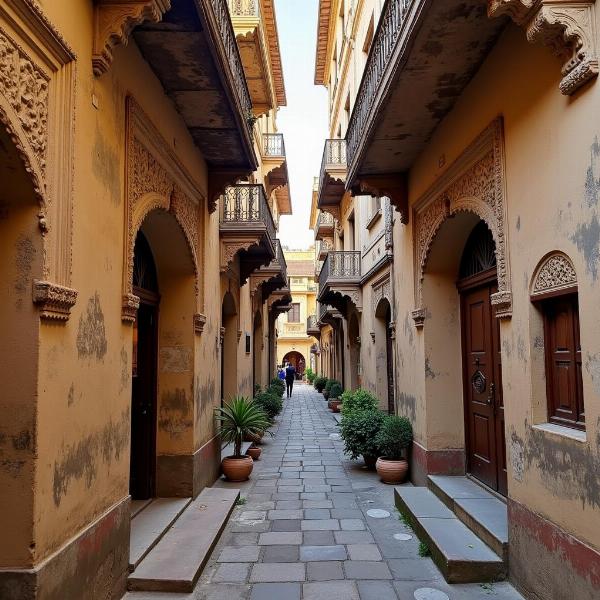Understanding the meaning of “alleys” in Hindi enriches our grasp of not only the language but also the cultural nuances associated with these spaces in Indian cities and towns. The Hindi translation of “alley” depends largely on the specific context, but some common equivalents include “gali” (गली), “kucha” (कुचा), and “patli gali” (पतली गली). These terms often evoke images of narrow, winding pathways, bustling with activity and community life. Knowing the right term to use can greatly improve your communication and understanding of Indian culture.
Navigating the Narrow Lanes: Gali, Kucha, and More
The most common and widely understood Hindi word for “alley” is “gali” (गली). This term generally refers to a narrow lane or passageway, often found in residential areas. “Gali” carries a sense of community, often associated with childhood games, neighborhood gossip, and the everyday rhythm of life in Indian towns and cities. Think of the vibrant, bustling lanes filled with the aroma of street food and the sounds of children playing – that’s the essence of a “gali.”
Another term often used is “kucha” (कुचा). While similar to “gali,” “kucha” sometimes implies a more secluded or less well-maintained alleyway. It can also refer to a dead-end alley. The word often conjures images of hidden corners and quieter, more intimate spaces within a bustling urban environment.
“Patli gali” (पतली गली), literally translating to “thin alley,” describes an exceptionally narrow passageway. This term emphasizes the limited space and can sometimes suggest a sense of confinement or intimacy.
Beyond the Literal: Cultural Significance of Alleys in India
Alleys in India are more than just physical spaces; they represent a vital part of the social fabric. They are places where communities thrive, relationships are forged, and daily life unfolds. These narrow lanes often hold a deep sense of history and tradition, reflecting the unique character of each neighborhood. From the intricate carvings on old buildings to the vibrant street art adorning the walls, alleys offer a glimpse into the heart of Indian culture.
Choosing the Right Word: Context is Key
When translating “alley” into Hindi, context plays a crucial role. Consider the specific characteristics of the alley you’re describing. Is it a bustling, lively lane or a more secluded, quieter passageway? Is it extremely narrow or relatively wide? By understanding these nuances, you can choose the most appropriate Hindi term and accurately convey the intended meaning.
What is the Hindi word for a very narrow alley?
The Hindi word for a very narrow alley is often “patli gali” (पतली गली), which literally translates to “thin alley”.
How are alleys perceived in Indian culture?
Alleys are often seen as integral parts of the community, fostering close relationships between neighbors and providing a unique space for daily life to unfold.
Dr. Archana Sharma, a renowned linguist and cultural expert, explains, “Alleys in India are vibrant microcosms of society. They are places where tradition and modernity intersect, and where the rich tapestry of Indian culture is woven thread by thread.”
 Old Buildings in Indian Alleys
Old Buildings in Indian Alleys
Professor Vivek Mishra, an urban anthropologist, adds, “Understanding the significance of alleys is essential to understanding the complex dynamics of urban life in India. They are spaces of both intimacy and community, reflecting the unique character of each neighborhood.”
In conclusion, understanding the meaning of “alleys” in Hindi, whether it’s “gali,” “kucha,” or “patli gali,” provides valuable insights into the cultural significance of these spaces in India. These terms represent more than just physical pathways; they embody the spirit of community, the rhythm of daily life, and the rich tapestry of Indian culture. By appreciating the nuances of these words, we can gain a deeper understanding and appreciation of India’s vibrant urban landscape.
FAQ:
- What is the most common Hindi word for “alley”? The most common Hindi word for “alley” is “gali” (गली).
- What does “kucha” mean in Hindi? “Kucha” (कुचा) typically refers to a more secluded or less well-maintained alleyway, sometimes a dead-end.
- What is the Hindi word for a very narrow alley? “Patli gali” (पतली गली) is used to describe a very narrow alley.
- Why are alleys important in Indian culture? Alleys are integral to Indian culture, representing community life, social interaction, and the unique character of neighborhoods.
- How does context affect the translation of “alley” into Hindi? The specific characteristics of the alley, such as its width and atmosphere, determine the most appropriate Hindi translation.
- What are some other words related to “alley” in Hindi? Other related words might include “rasta” (रस्ता) for road or path, and “marg” (मार्ग) for way or route.
- Where can I find more information about Hindi language and culture? You can find more information on Meaning-Hindi.in.
meaning of deformation in hindi
zipline meaning in hindi
Meaning-Hindi.in is your one-stop solution for all your Hindi translation needs. We specialize in a wide range of translation services, including business and commercial document translation, certified and legal document translation, technical and user manual translation, website and localization, educational and academic document translation, and fast and urgent translation services. Our expert linguists ensure accurate and culturally sensitive translations, capturing the nuances of both Hindi and the source language. Contact us today for a free quote at [email protected] or call us at +91 11-4502-7584. Meaning-Hindi.in is dedicated to bridging language barriers and fostering cross-cultural understanding.